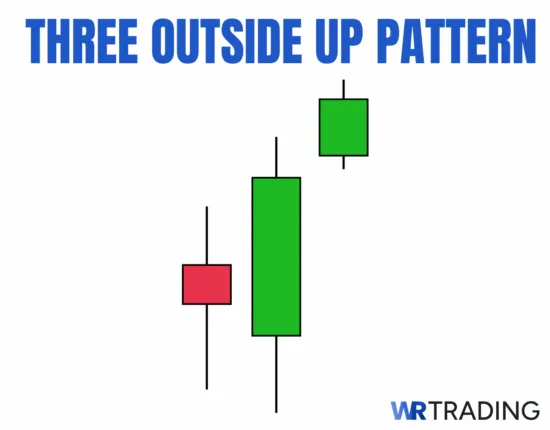
Three Outside Up is a three-candle bullish reversal pattern that appears after a downtrend or near the end of a corrective pullback. It starts with a red candle showing continued selling pressure, followed by a large green candle that completely engulfs the previous body, and ends with a second green candle closing even higher. This clear sequence shows that control has shifted from sellers to buyers, confirming the start of a potential trend reversal.
The pattern reflects a shift in market sentiment where buyers regain control after a period of weakness. It forms in areas where bearish momentum is fading, such as near support zones, prior lows, or the end of corrective legs in broader uptrends. Traders use it to confirm reversal setups, especially when the structure is supported by volume, momentum indicators, or price confluence. The Three Outside Up Pattern is easy to identify with clean, consecutive price action and works well near support zones or after extended downward moves.
Now we’ll go into greater detail about everything you should know about the Three Outside Up candlestick pattern.
Key Facts of the Three Outside Up Pattern:
- Type of Pattern: Three-candle bullish reversal pattern
- Construction:
- First Candle: A bearish candle that extends the prior downtrend, closing near its lows and showing continued seller control
- Second Candle: A strong bullish candle that opens within the first candle’s body and fully engulfs it, closing well above the first candle’s open
- Third Candle: Another bullish candle that opens higher or near the second candle’s close and pushes even higher, confirming that buyers have taken full control
- Forecast: Signals a potential shift to bullish momentum, suggesting a reversal or start of a new uptrend if confirmed by continued strength
- Trend Prior to Pattern: Forms after a downtrend, corrective pullback, or series of lower closes, often near support levels or swing lows
- Opposite Pattern: Three Outside Down
- Stop-Loss Placement: Commonly placed just below the low of the second or third candle, or beneath the structure low, depending on the nearby support area
- Candlestick Success Rate: Estimated around 70%
How Does a Three Outside Up Candlestick Pattern Form?
The pattern begins with a red candle that continues the existing selling pressure. The second candle opens within the first and closes above its high, completely engulfing the body. This engulfing move is the key signal as buyers have absorbed the previous session and pushed back with strength. The third candle follows through, closing even higher to confirm the reversal and shift in momentum.
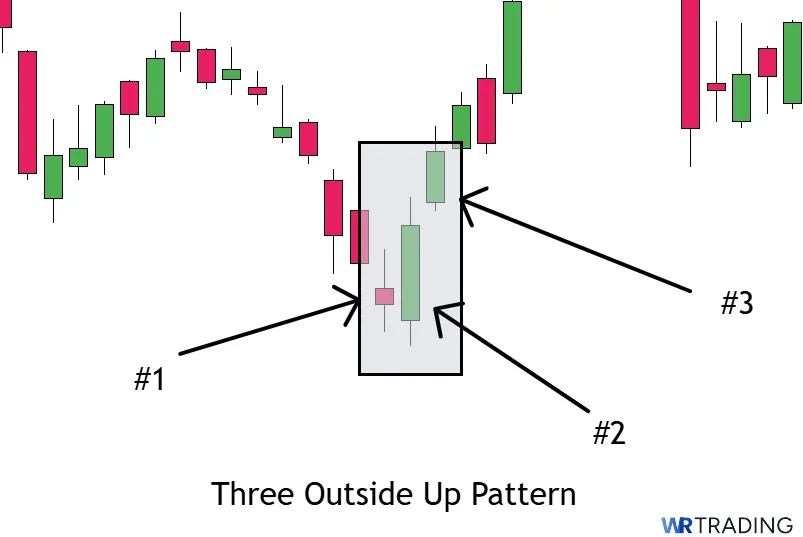
The Three Outside Up pattern forms over three candles and signals a reversal from bearish to bullish control. It appears after a short-term downtrend, corrective pullback, or series of lower closes. Price action leading up to the setup shows weakness, such as smaller red candles, failed breakdowns, or price stalling near support. It always forms over three consecutive candles and can appear on any timeframe. On a 4-hour or daily chart, it forms over three sessions.
What Does the Three Outside Up Candlestick Pattern Mean?
The Three Outside Up pattern marks a clear change in sentiment from bearish to bullish. It tells you that sellers were in control, but buyers stepped in with enough strength to not only reverse a session but follow through into the next one. The first candle shows the last push from sellers. The second candle completely engulfs it, which is the key moment of reversal, as buyers have overpowered the prior move. The third candle confirms it wasn’t just a reaction; momentum is now shifting upward.
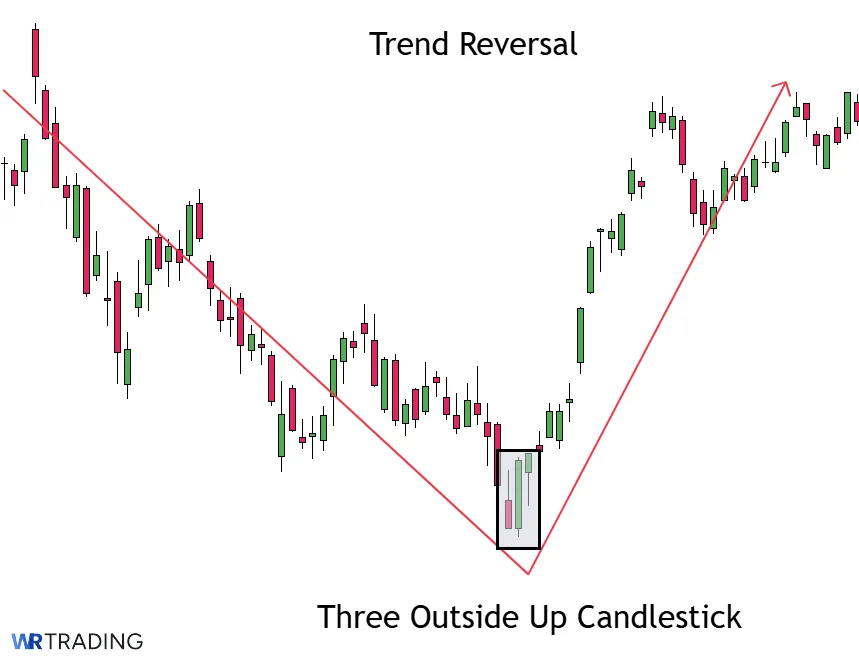
Traders interpret this pattern as a strong signal that the downtrend is losing strength and a potential rally is beginning. It’s most meaningful when it forms near key levels such as swing lows, horizontal support, or the bottom of a correction. When these conditions line up, the pattern reflects growing confidence among buyers and opens the door for upward continuation or a full trend reversal.
Example of the Three Outside Up Pattern in the Chart
Below you can see an example of how this Three Outside Up Pattern emerges from a chart history, how to read it and what meaning it has.
The first red bearish candle has its low at 27.32 USD and its high at 28.48 USD. The second candle opens below the daily low of the previous red candle and closes above the previous day’s high. The third candle confirms the candlestick reversal pattern and closes above the second candle.
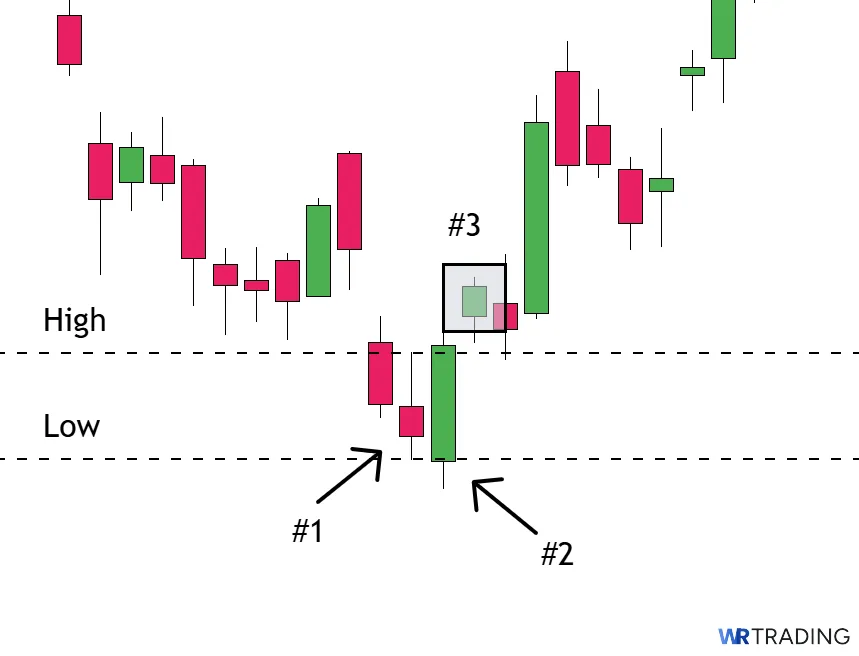
How to Identify a Three Outside Up Candle in the Chart?
To find the Three Outside Up pattern, look at charts where the price has been moving down for several sessions. It can be a clean downtrend or a short-term pullback inside a broader uptrend. The most reliable signals occur near known support zones or after the price has bounced off a prior low.
Search for this pattern on timeframes like the 4-hour or daily chart since there is less noise. Use tools like trendlines, Fibonacci retracements, or horizontal levels to mark out zones where buyers have reacted before. These areas are where this pattern tends to appear. Once the price starts reversing from that level, and the pattern fits cleanly, that’s where you focus your attention.
How to Trade the Three Outside Up Candlestick Pattern
Trading the Three Outside Up candlestick pattern isn’t just about spotting three candles on a chart, it involves understanding context, timing, tools, and risk management. The better you can connect these factors, the more consistently you’ll capture profitable trades.
Let’s explore a step-by-step approach that covers:
- Find the Right Three Outside Up Candlestick Pattern Setup
- Wait for the Appearance of the Three Outside Up Candle
- Open Your Trade – Entry Point
- Choose Your Trading Take Profit
1. Find the Right Three Outside Up Candlestick Pattern Setup
The first step to trading the Three Outside Up pattern is identifying a market that’s already moving lower but showing signs of selling exhaustion. Focus on charts where the price has been falling but selling pressure is weakening – smaller-bodied candles, long lower wicks, or choppy pullbacks instead of clean drops.
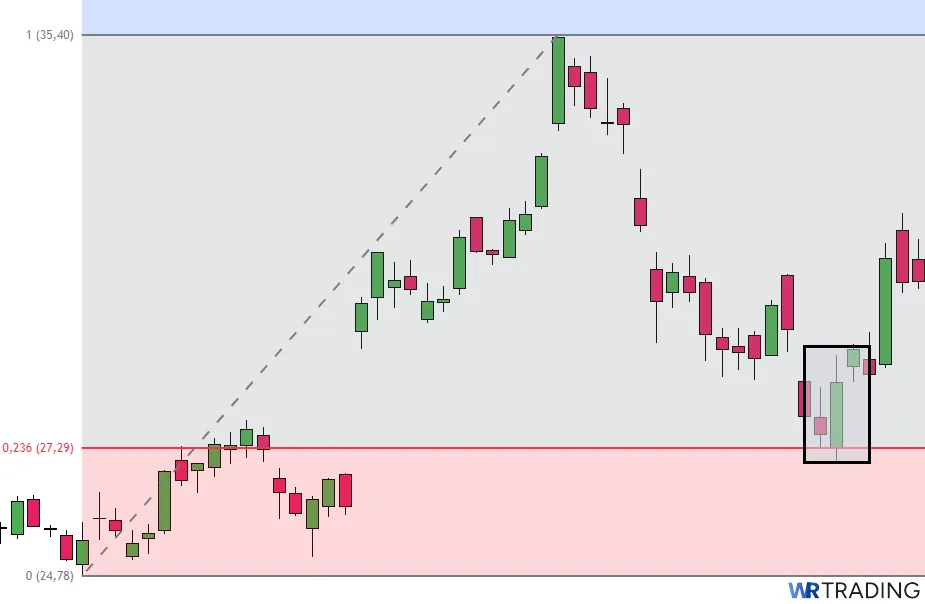
This hints that sellers are struggling to continue the trend. The best places to look are near strong support levels, prior swing lows, round number zones (like 1.2000, 1800), or Fibonacci retracement areas, typically the 50% or 61.8% level.
Also, check momentum indicators like RSI as well. If RSI is showing oversold readings or bullish divergence (the price is making lower lows but RSI is making higher lows), it adds confirmation that momentum could soon flip. Traders also monitor volume as declining volume during the selloff, followed by increasing volume signals stronger conviction from buyers.
2. Wait for the Appearance of the Three Outside Up Candle
After finding a favorable zone, you need the full Three Outside Up structure to form: a bearish candle, a bullish candle that fully engulfs it, and a second bullish candle closing even higher. These three candles should form cleanly without large overlaps or confusing price action around them. Gaps between sessions can happen on daily charts, but the core pattern must remain intact.
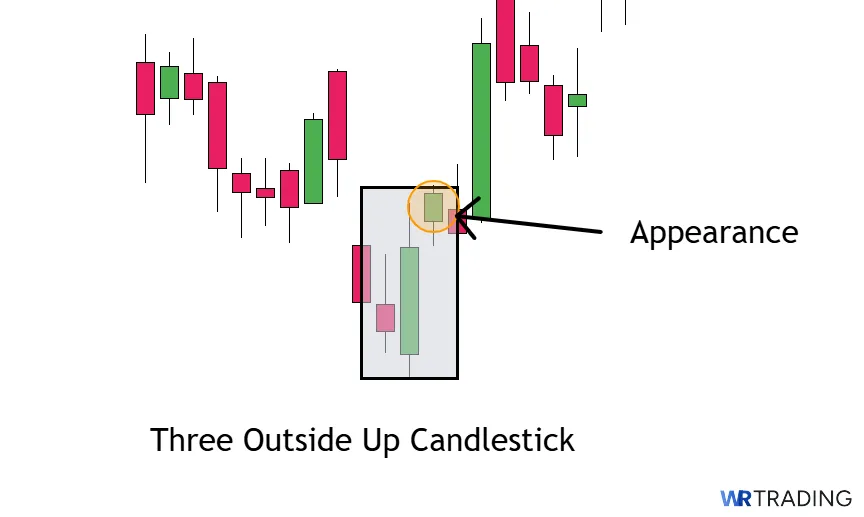
It’s useful to keep a trendline or support zone marked on your chart while waiting. When the engulfing and follow-through happen around these levels, the probability of success increases. Traders avoid setups that form in the middle of ranges without any major technical relevance, as these tend to fail more often.
3. Open Your Trade – Entry Point
The ideal entry for the Three Outside Up setup is immediately after the third candle closes. Conservative traders might wait for a slight pullback toward the midpoint of the third candle’s body for a better risk-reward ratio. In both cases, the stop-loss is placed just beneath the low of the entire pattern or slightly under the nearby support zone to give the trade room to breathe.
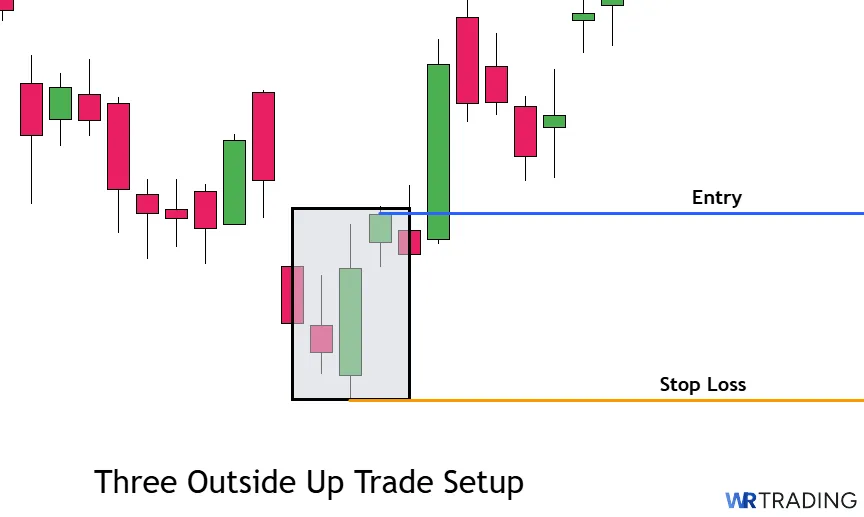
Volume confirmation on the third candle’s close is a major plus. If volume increases compared to prior sessions, it confirms participation from real buyers, not just short-covering. Some traders use moving averages like the 20 EMA, which adds an extra layer of confluence for the entry.
4. Choose Your Trading Take Profit
Setting targets depends on the surrounding market structure. The first logical target for the Three Outside Up pattern is the nearest swing high or resistance zone that the price recently failed to break. In strong trending markets, traders can aim for higher targets by using Fibonacci extensions, such as the 127.2% or 161.8% levels from the prior swing.
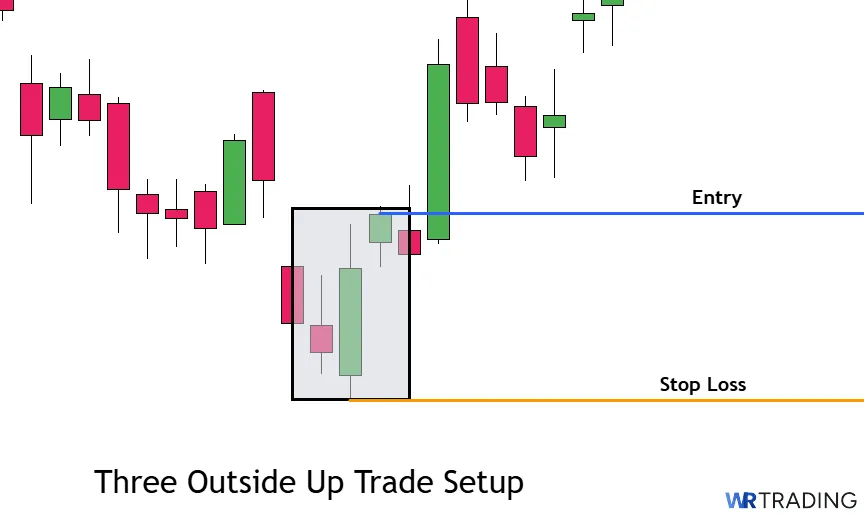
Managing the trade actively is just as important as setting it up. As the price moves in your favor, moving the stop to break-even or trailing it below higher lows can help protect gains. If momentum indicators like RSI move toward overbought, partial profits can be taken to lock in some gains while allowing the rest of the trade to run.
What Are The Best Trading Strategies For The Three Outside Up Candlestick Pattern?
The Three Outside Up offers multiple ways to trade a reversal once selling pressure weakens. While the pattern itself is powerful, the best setups come from combining it with broader market context, technical tools, and clear risk management. Traders who focus only on the candles without considering structure or confirmation often miss the highest-probability moves.
Here are three effective strategies for using the Three Outside Up in real-world trading:
- Support Bounce with Moving Averages
- Oversold Reversal with RSI and Divergence
- Reversal After Failed Breakout
1. Support Bounce with Moving Averages
One proven approach is trading the Three Outside Up when it forms at a strong support level combined with dynamic moving average support. Look for charts where the price pulls back into an area near the 50 EMA or 100 EMA, aligning with a horizontal support level. The moving average should still be sloping upward, showing that the broader trend remains intact.
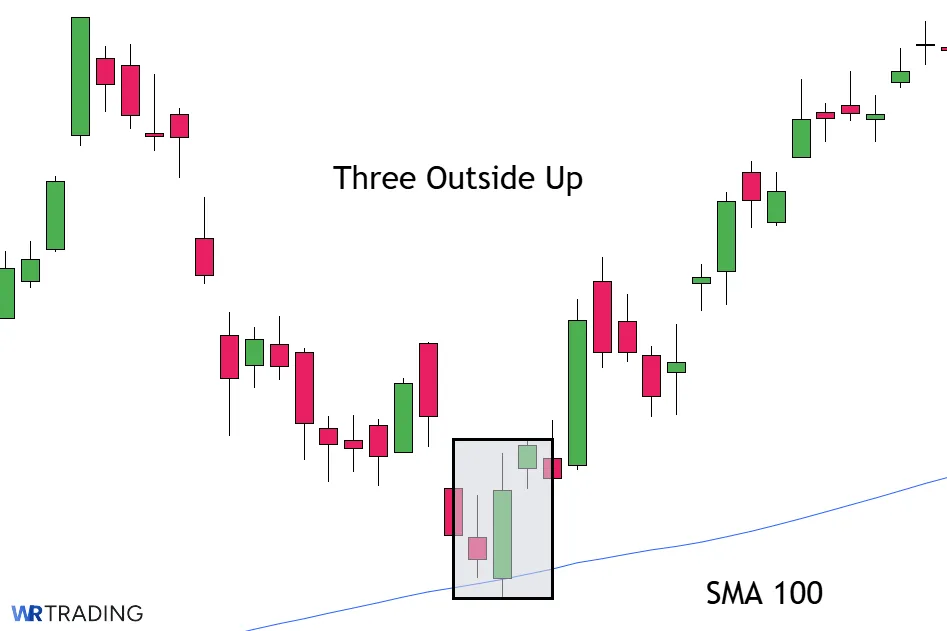
When the Three Outside Up forms in this zone, it signals that buyers are stepping in to defend the trend. Entries are placed after the third candle closes. Stops are positioned slightly below the moving average or the lowest point of the pattern.
Profit targets focus on the prior swing high, with additional targets at 127.2% or 161.8% Fibonacci extension levels if momentum continues. Combining static and dynamic support gives stronger conviction for the trade.
2. Oversold Reversal with RSI and Divergence
Another strategy is spotting the Three Outside Up during an oversold RSI condition when bullish divergence is present. Traders watch for RSI readings below 30, indicating extreme selling pressure. If the price forms a lower low while RSI forms a higher low, it signals hidden buying strength.
When a Three Outside Up follows this divergence, it acts as a strong confirmation that momentum is shifting. Trades are entered at the close of the third candle, and stops are placed below the recent swing low or pattern low.
Profit targets are set around previous resistance zones or projected using Fibonacci tools. RSI recovering above 40 or 50 after entry provides additional confirmation to hold the trade for larger moves.
3. Reversal After Failed Breakout
Sometimes markets attempt to break support but fail, trapping sellers. Monitor support zones where false breakdowns have occurred. When the price breaks briefly below support but quickly reclaims it and prints a Three Outside Up pattern, it can signal that sellers are trapped and buyers are in control.
The entry is placed after the third candle closes above the reclaimed level. Stops are placed just beneath the fakeout low. Volume is important in this setup; rising volume on the reclaim and during the Three Outside Up formation strengthens the signal. Targets are initially set at the previous highs where sellers last controlled the market, with secondary targets based on how aggressively buyers push the move.
What Is The Success Rate Of The Three Outside Up Candlestick Pattern?
The Three Outside Up candlestick pattern has a success rate estimated at around 70% according to Thomas Bulkowski’s Encyclopedia of Candlestick Charts. Bulkowski’s testing showed that this pattern performs better when it appears after strong downward trends or near significant support zones.
However, the success rate can vary depending on several factors, such as market conditions, timeframe, volume levels, and confirmation signals. Traders who use it in isolation without technical analysis may experience lower reliability. Therefore, many traders combine it with momentum indicators or price structure zones for additional confirmation.
What Are the Pros and Cons of Trading the Three Outside Up Candle Pattern?
Trading the Three Outside Up has clear advantages when used in the right conditions, but it also carries risks that traders need to manage carefully. Here’s a full breakdown of where the pattern performs well and where it can fall short.
Pros
- Provides a strong reversal signal through engulfing action
- Helps traders spot turning points after downtrends
- Fits naturally into pullback continuation strategies
- Works strongly when combined with support zones
- Helps catch reversals early before lagging indicators react
Cons
- Depends heavily on clean formation
- Fails frequently in weak markets
- Volume confirmation is often overlooked
- Gaps and volatility distort the structure
- Psychology of “chasing the reversal” risk
What Are The Advantages Of The Three Outside Up Pattern?
Understanding the strengths of the Three Outside Up helps traders recognize when the market is shifting in their favor. Knowing what makes this pattern effective becomes easier to plan for entries, manage risk, and build more confident trading setups. These are the main advantages of the Three Outside Up:
- Provides a strong reversal signal through engulfing action: The Three Outside Up creates immediate visual impact by showing buyers completely engulfing the previous bearish session. This aggressive bullish takeover makes it clear that sellers have lost control. Traders don’t need to second-guess momentum shifts because the price action visibly confirms the change.
- Helps traders spot turning points after downtrends: When it appears after a clear series of lower highs and lower lows, the Three Outside Up signals that a downtrend could be ending. This offers a well-timed opportunity for traders to position early into a potential trend reversal, improving both risk control and potential reward.
- Fits naturally into pullback continuation strategies: The Three Outside Up is not only a reversal signal but can also appear during healthy uptrend pullbacks. When the Three Outside Up forms after a retracement to support or a moving average, it confirms that the larger bullish trend remains intact. This dual-purpose behavior makes it very adaptable for different trading plans.
- Works strongly when combined with support zones: If the Three Outside Up prints at major horizontal support, psychological price levels, or near the lower Bollinger Band, it becomes even more powerful. These areas already attract buyers, and the pattern provides technical proof that support is holding and attracting demand.
- Helps catch reversals early before lagging indicators react: Because the Three Outside Up forms quickly after bearish momentum weakens, it often appears before indicators like moving average crossovers or MACD shifts. This timing advantage allows traders to act early, capturing more of the move rather than reacting late.
What Are The Disadvantages Of The Three Outside Up Pattern?
While the Three Outside Up offers strong visual confirmation of buying pressure, it has weaknesses that can catch traders off guard. Recognizing where the pattern struggles helps avoid chasing false reversals and improves overall decision-making.
- Depends heavily on clean formation: The Three Outside Up only works when the engulfing and follow-through candles are clean and decisive. Sloppy structures with partial overlaps or weak closes can easily lead to fake reversals. Clarity matters for this pattern more than for simpler setups.
- Fails frequently in weak markets: If overall market conditions remain bearish, the pattern can fail quickly even after a textbook setup. Sellers might overpower the new buyers almost immediately. Checking broader market sentiment is critical before trusting the reversal.
- Volume confirmation is often overlooked: Many traders enter Three Outside Up setups without checking if buying volume has increased. Weak volume during or after the pattern formation signals a lack of real conviction from buyers. Volume is essential to validate the strength behind the move.
- Gaps and volatility distort the structure: On higher volatility assets, large gaps between candles can stretch or distort the appearance of the pattern. When this happens, the reliability drops significantly, and traders need to be extra cautious with entries and stops.
- Psychology of “chasing the reversal” risk: Many traders are emotionally drawn to bullish reversal patterns after heavy selling. This emotional attachment can cause traders to overestimate weak setups. It’s important to stay objective and not overtrust the pattern without full confirmation.
Can the Three Outside Up Pattern Have Failure Signals?
Yes, the Three Outside Up pattern can produce false signals when the broader market context is missing. Learning how and when it fails can help you filter better setups and protect your trades.
- Appears in a ranging or choppy market: When the pattern forms inside a sideways market without a real downtrend behind it, it loses much of its meaning. Reversals require prior momentum to break. Without clear downside pressure first, bullish breakouts often fail quickly.
- Second candle fails to fully engulf the first: The engulfing candle must completely cover the body of the first red candle. If it doesn’t, the structure weakens and the pattern is incomplete. Partial engulfings often lead to fakeouts rather than true reversals.
- Formation away from major support levels: If the pattern prints randomly in open space without nearby support, buyers don’t have a strong base to build from. Strong technical locations give reversals more weight. Without support, sellers often reassert quickly.
- Broad trend remains bearish on higher timeframes: A bullish Three Outside Up on a 4-hour chart means little if the daily or weekly trend is still pushing down hard. Short-term reversals against dominant trends tend to fail faster. Always align entries with bigger structures when possible.
- RSI not showing oversold conditions before setup: If RSI or similar momentum indicators don’t show oversold conditions during the Three Outside Up Pattern, the bounce lacks internal pressure. True reversals happen when sellers are exhausted, not when momentum is still bearish.
- Overlapping or distorted candles: If the engulfing and confirmation candles are messy or have confusing wicks, the pattern’s clarity is compromised. Clean setups are important because they reflect real conviction from buyers. Messy candles hint at indecision.
Which Indicators Can Be Combined With The Three Outside Up Pattern?
Adding confirmation indicators to the Three Outside Up makes it easier to trust bullish reversals, especially after strong selling. Tools that measure momentum shifts, trend recovery, and buyer strength help separate strong patterns from weaker ones.
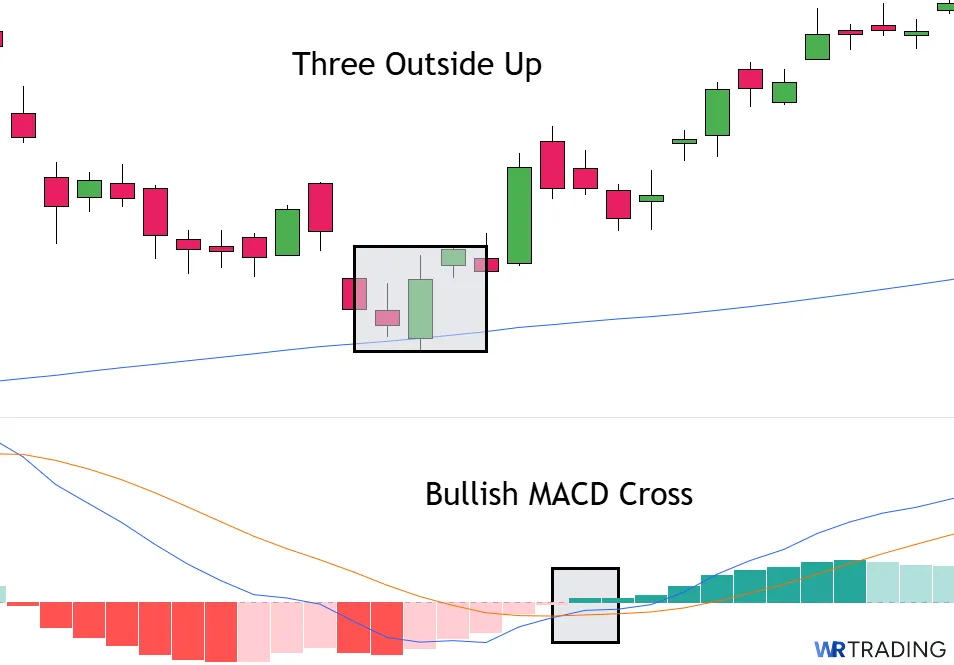
- RSI Oversold Bounce: When the Three Outside Up forms while RSI is below 30 and starts climbing, it signals that selling pressure is exhausted. Traders using standard 14-period RSI settings can watch for a bounce above 30 as additional confirmation. This combination improves the odds of a sustained bullish move.
- MACD Bullish Cross: A bullish MACD crossover occurring around the second or third candle strengthens the Three Outside Up setup. Using settings like 12, 26, 9, traders look for the MACD line crossing above the signal line. A fresh crossover supports the idea that momentum has shifted toward buyers.
- Volume Spike on the Second or Third Candle: Volume rising sharply during the engulfing or confirmation candle gives the pattern much more weight. Ideally, traders want to see volume exceeding the previous 10 to 15 sessions. Higher volume confirms real buying participation, not just short-covering or thin moves.
- Bollinger Band Compression and Expansion: If the Three Outside Up forms after price touches or dips outside the lower Bollinger Band, it adds another layer of confirmation. Default settings (20-period moving average, 2 standard deviations) work well. Re-entering the bands after touching the lower band shows volatility expansion and trend reversal potential.
- 200 EMA Recovery: If price climbs back above the 200 EMA after forming the Three Outside Up, it’s a strong technical recovery sign. The 200 EMA is one of the most-watched moving averages across markets. Reclaiming it after a reversal pattern dramatically improves bullish continuation odds.
Alternatives to the Three Outside Up Pattern:
| Pattern | Type of Pattern | Best Use Case | Key Characteristics / Conditions |
|---|---|---|---|
| Bullish Abandoned Baby | Bullish Reversal (3 Candles) | Catching clean reversal setups after sharp selloffs and gap isolation. | First candle bearish, second candle gapped down doji, third candle gaps up and closes bullish, isolating the middle candle completely. |
| Dragonfly Doji | Bullish Reversal (Single Candle) | Spotting aggressive rejection of lower prices at support zones. | Open, high, and close occur near the same price with a long lower shadow, showing strong buyer defense. |
| Inverted Hammer | Bullish Reversal (Single Candle) | Finding early signs of a bottom after a downtrend. | Small real body near the low of the range, long upper wick, suggests an attempt by buyers to reverse the trend. |
| Three White Soldiers | Bullish Continuation (3 Candles) | Confirming strength in an ongoing uptrend rather than a fresh reversal. | Three long bullish candles with higher closes each day, showing strong, persistent buying momentum. |
| Mat Hold Pattern | Bullish Continuation (5 Candles) | Identifying brief consolidations before a strong continuation of an uptrend. | Strong bullish candle, three small corrective candles, then a bullish breakout candle continuing the trend direction. |
Learn more alternatives in our WR Trading Candlestick Pattern Bible for free.
What Is the Difference Between the Three Outside Up and the Three Outside Down Pattern?
The Three Outside Up and Three Outside Down patterns are built with the same three-candle structure but predict completely opposite market movements. The Three Outside Up forms after a downtrend and shows that buyers have gained control through an engulfing bullish candle followed by confirmation.

Meanwhile, the Three Outside Down forms after an uptrend and signals that sellers have gained control by engulfing bullish momentum and following through lower. Although their formations mirror each other in construction, the underlying psychology and expected price direction are direct opposites.
| Section | Three Outside Up | Three Outside Down |
|---|---|---|
| Construction | First Candle: Bearish candle continuing the downtrend. Second Candle: Bullish candle fully engulfs the previous red candle. Third Candle: Another bullish candle closes higher, confirming buyer strength. | First Candle: Bullish candle continuing the uptrend. Second Candle: Bearish candle fully engulfs the previous green candle. Third Candle: Another bearish candle closes lower, confirming seller strength. |
| Forecast | Signals a shift from bearish momentum to bullish control, suggesting the price may rise further. | Signals a shift from bullish strength to bearish control, suggesting the price may fall further. |
| Type of Pattern | Three-candle bullish reversal pattern. | Three-candle bearish reversal pattern. |
| Trend Prior to Pattern | Forms after a clear downtrend or corrective pullback, where sellers are losing strength. | Forms after a rally or extended uptrend, where buyers are becoming exhausted. |
| Opposite Pattern | Three Outside Down. | Three Outside Up. |
What Are The Limitations Of The Three Outside Up?
The Three Outside Up is a strong bullish setup with a few limitations. Poor structure or missing confirmation can make it less effective, these are the main flaws you should know:
- Loses strength if there’s no clear downtrend before the pattern forms.
- Small engulfing candles weaken the pattern’s bullish momentum.
- Often fails when volume doesn’t confirm the reversal.
- Can act as a short-term bounce instead of a full reversal.
- News-driven events can easily override the pattern’s signal.
Learn Pattern Trading With the WR Trading Mentoring
Trading the Three Outside Up pattern is about more than recognizing an engulfing move after a downtrend. It is about understanding the shift in pressure between buyers and sellers, spotting where real demand is entering the market, and knowing when the conditions actually support a sustained reversal.
That is exactly the focus of WR Trading Mentoring. You are taught how to judge the strength behind a pattern, how to combine it with key technical factors like support zones and volume confirmation, and when to step in with calculated risk, rather than reacting emotionally to a strong candle.
Instead of relying on a single setup, WR Trading trains you to connect patterns like the Three Outside Up into the larger flow of the market. You learn how to spot exhausted downtrends, how to time entries when confirmation aligns across multiple timeframes, and how to plan exits around real structural levels, not random price points.
Conclusion: The Three Outside Up Pattern as a Reliable Signal for Bullish Reversals
The Three Outside Up is one of the cleanest and most reliable bullish reversal patterns available to traders. When it forms at strong technical levels like support zones or after clear exhaustion from sellers, it provides a structured way to spot the start of a trend shift before lagging indicators react. Its three-candle design, combined with confirmation through engulfing action and follow-through strength, makes it highly valuable for those looking to trade reversals with discipline.
However, like every candlestick pattern, the Three Outside Up must be used with proper context, volume analysis, and risk management. It performs best when paired with momentum tools, structural analysis, and a full understanding of trend behavior. Learn to filter clean setups and combine them with broader technical evidence, and you will find that the Three Outside Up can be a strong part of a professional trading strategy.
FAQs: Most Frequently Asked Questions on Bullish Kicker Pattern
What Does a Three Outside Up Pattern Indicate?
The Three Outside Up pattern shows a potential bullish reversal. It shows that buyers have stepped in strongly enough to engulf prior selling momentum. Traders view it as an early sign of a possible trend change.
How Reliable Is the Three Outside Up Pattern?
It’s considered a reliable pattern when supported by strong volume and forming near major support levels. Without confirmation, it can sometimes act as a short-term bounce rather than a full reversal.
How Do You Confirm a Three Outside Up Pattern?
The pattern is confirmed when the third bullish candle closes higher than the second, showing momentum follow-through. Additional confirmation can come from volume spikes, trendline breaks, or higher timeframe support holding firm. Stronger confirmations lead to better setups.
Can Beginners Use the Three Outside Up Pattern?
Yes, beginners can learn this pattern fairly easily because of its visual clarity. However, it is important to practice confirming setups with real trend analysis, not just candlestick recognition. A pattern by itself is not enough without the bigger picture.



